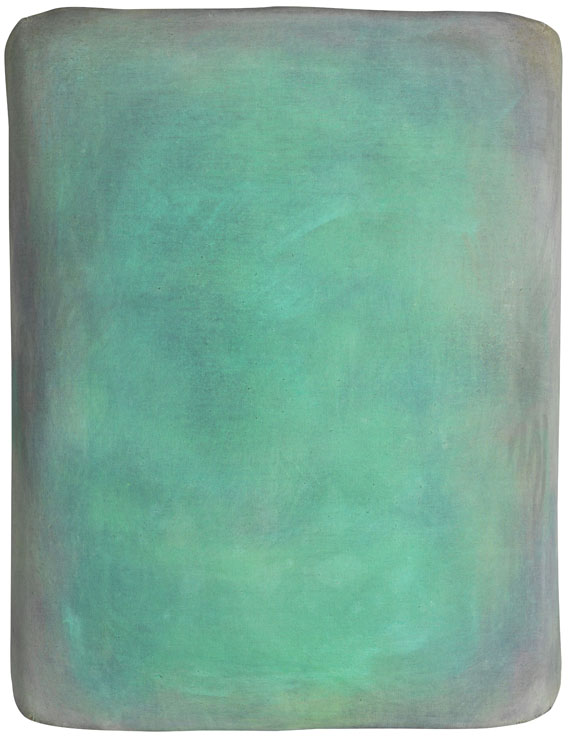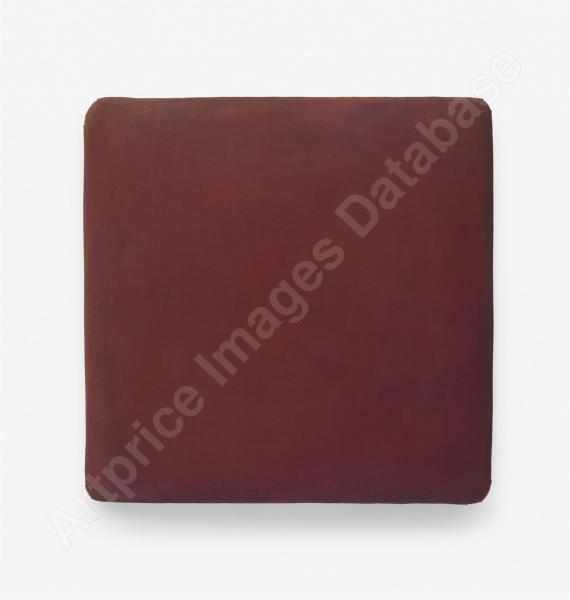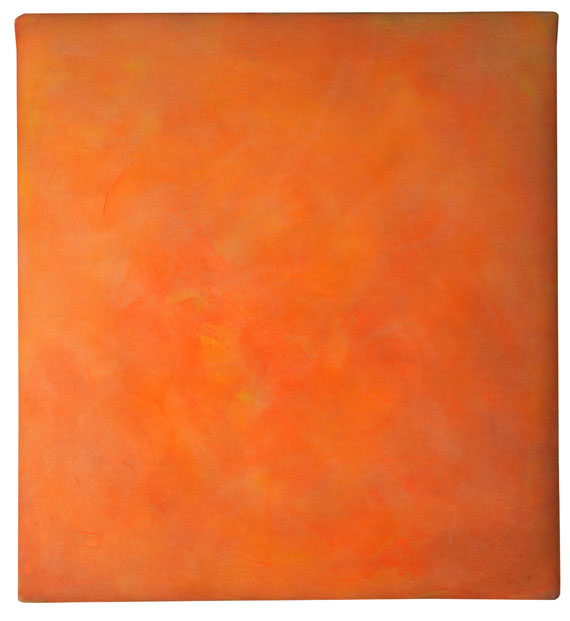124000225
Gotthard Graubner
Ohne Titel, 1992–199.
Mixed media on canvas over synthetic wadding on...
Stima: € 150,000 / $ 160,500
Le informationi sulla commissione, le tasse e il diritto di seguito saranno disponibili quattro settimane prima dell´asta.
Ohne Titel. 1992-1996.
Mixed media on canvas over synthetic wadding on canvas.
Signed and dated on the reverse. 110 x 110 x 16 cm (43.3 x 43.3 x 6.2 in).
• Innovative aesthetics: Graubner's famous “Farbraumkörper” (Color Space Bodies) transcend the boundaries of classic panel painting.
• A maximum liberation, deep color effects with a fascinating spatial presence.
• Graubner's three-dimensional “color space painting” became his unique feature.
• Four years before this work was made, Graubner created the two famous “Farbraumkörper” for Berlin's Bellevue Palace.
• Most recently, the MKM Museum Küppersmühle in Duisburg, among others, honored Graubner's oeuvre in the exhibition “Farbe Absolut. Katharina Grosse x Gotthard Graubner” (2019/20).
• Comparable works can be found in the Städel Museum, Frankfurt am Main, in the Collection of Contemporary Art of the Federal Republic of Germany, Berlin, and the Neue Nationalgalerie, Berlin.
PROVENANCE: Galerie Karsten Greve, Cologne (with the label on the stretcher).
Private collection (acquired from the above - until 2017: Christie's, December 12, 2017, lot 48).
Private collection Southern Germany (acquired from the above in 2017).
LITERATURE: Christie's, Amsterdam, Auction 14879, Post War and Contemporary Art, December 13, 2017, lot 48 (illu.).
"The surfaces show open, often cloudy, moving, boundless structures, they are not rigid and ensure a constant exchange between inside and outside, like regular breathing. The paintings evolve into a sensory experience through color. "
Julia Mattern, Wandlungen/Transformations, in: Gotthard Graubner. Mit den Bildern atmen / Breathing with the Paintings, Cologne 2018, p. 22.
Mixed media on canvas over synthetic wadding on canvas.
Signed and dated on the reverse. 110 x 110 x 16 cm (43.3 x 43.3 x 6.2 in).
• Innovative aesthetics: Graubner's famous “Farbraumkörper” (Color Space Bodies) transcend the boundaries of classic panel painting.
• A maximum liberation, deep color effects with a fascinating spatial presence.
• Graubner's three-dimensional “color space painting” became his unique feature.
• Four years before this work was made, Graubner created the two famous “Farbraumkörper” for Berlin's Bellevue Palace.
• Most recently, the MKM Museum Küppersmühle in Duisburg, among others, honored Graubner's oeuvre in the exhibition “Farbe Absolut. Katharina Grosse x Gotthard Graubner” (2019/20).
• Comparable works can be found in the Städel Museum, Frankfurt am Main, in the Collection of Contemporary Art of the Federal Republic of Germany, Berlin, and the Neue Nationalgalerie, Berlin.
PROVENANCE: Galerie Karsten Greve, Cologne (with the label on the stretcher).
Private collection (acquired from the above - until 2017: Christie's, December 12, 2017, lot 48).
Private collection Southern Germany (acquired from the above in 2017).
LITERATURE: Christie's, Amsterdam, Auction 14879, Post War and Contemporary Art, December 13, 2017, lot 48 (illu.).
"The surfaces show open, often cloudy, moving, boundless structures, they are not rigid and ensure a constant exchange between inside and outside, like regular breathing. The paintings evolve into a sensory experience through color. "
Julia Mattern, Wandlungen/Transformations, in: Gotthard Graubner. Mit den Bildern atmen / Breathing with the Paintings, Cologne 2018, p. 22.
Four years before he made the present work, Gotthard Graubner created the two huge "Color Space Bodies" called "Begegnungen" (Encounters) for Bellevue Palace, the residence of the German President in Berlin. Today the two violet and yellow works still adorn the two end walls of the Great Hall and fill the room with their tremendous color tone. While Graubner covered his early cushion paintings with fine nylon fabrics, he increasingly used solid canvas fabrics backed with wadding for his later, larger-format "Color Space Bodies" like in our vibrant work. The paint, which evokes a cloudy depth, is usually applied onto the substrate on the floor using a wide variety of broom-like brushes. To increase the complexity and depth of the individual color values - such as the nuanced, condensed green in our outstanding work - into a body of color and space characterized by an oscillating effect and a unique aesthetic presence, numerous drying processes, and a special compositional sensitivity are required - a crucial feature of Graubner's painterly oeuvre. Starting with watercolors and then on canvas, Graubner experimented with forms of paint application that gave the multiple layers of paint priority over the limiting form of the picture's edges. To enhance the spatial effect, Graubner began to cover paint cushions with Perlon fabric in the early 1960s. By soaking and painting the fabric cushions with several layers of diluted acrylic paint beforehand, Graubner achieved a fluctuating, breathing densification similar to a color space that reaches out to the viewer. Eventually, Graubner replaced the older work designations "Farbleib" (Color Body) and "Kissenbild" (Cushion Picture) with the term "Farbraumkörper" (Color Space Body) in 1970. These impressive creations were first exhibited by the important Düsseldorf gallerist Alfred Schmela, who was also one of the first to present the young "ZERO" artists in the 1960s, as well as Gerhard Richter's first solo exhibition in 1964. Graubner was a progressive eccentric and at the same time a child of his time, considering that Frank Stella also tried to break the boundaries of the classic panel painting with his "Shaped Canvases" in the 1960s, and thus - just like Graubner - wanted to achieve the greatest possible congruence between form and content. In 1968, Graubner showed his early "Cushion Pictures" at the documenta in Kassel. In 1969, Graubner was appointed professor at the University of Fine Arts in Hamburg. From the 1980s onward, Graubner finally achieved a maximum dissolution of the color effect's boundaries in his large "Farbraumkörper" (Color Space Bodies), of which the present work is a striking example. The structure of the coarse canvas supports the color's pure effect, entirely liberated from the boundaries of form. It does not appear flat, but sculptural, and can unfold and achieve a hidden, slightly implied sculptural effect. Due to the innovative aesthetics of this three-dimensional painting, Graubner's "Farbraumkörper" is considered the central work complex in his oeuvre. [JS]
124000225
Gotthard Graubner
Ohne Titel, 1992–199.
Mixed media on canvas over synthetic wadding on...
Stima: € 150,000 / $ 160,500
Le informationi sulla commissione, le tasse e il diritto di seguito saranno disponibili quattro settimane prima dell´asta.




 Lot 124000225
Lot 124000225 


